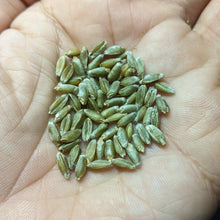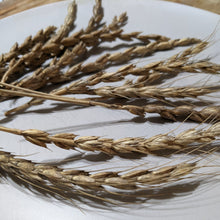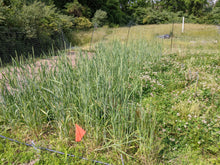Tim Peters Perennial Wheat Grex
Regular price
$6.00
Sale
x Agrotriticum spp.
Origin: Oregon
Improvement status: Breeding population
Seeds per packet: ~40
Germination tested 12/2023: 98%
Life cycle: Perennial
EFN INTRODUCTION. Ten years after planting the first perennial wheat seeds we could get our hands on, we are delighted to finally be offering EFN-grown perennial wheat seeds in our catalogue for the first time in 2023! Perennial wheat has been the holy grail for agronomists for over a century — and it was stories about the failure to develop and commercialize perennial wheat that convinced co-founder Nate Kleinman that a project like the Experimental Farm Network was worth undertaking.
Before we go any further, we should be clear about one thing: this is not improved perennial wheatgrass — dubbed "kernza" by The Land Institute (and "triga" by Rodale Institute before them) — but rather true perennial wheat, developed from hybrids between wheat (Triticum spp.) and wheatgrass (Thinopyrum spp.), backcrossed with wheat.
Perennial crop plants are far more environmentally sustainable than annuals. They reduce soil erosion, minimize water runoff, require fewer external inputs, create habitat for a variety of creatures (from soil microorganisms to insects to birds), and — most importantly — sequester carbon in the ground, making them potent weapons against global climate change. This is why plant breeders have worked since the early 20th century to develop perennial grains into viable commercial crops.
American and Russian scientists conducted some of the key early work in perennial wheat development in the early 20th century. Soviet plant breeder Nikolai Vasilievich Tsitsin (see photo) made the first successful crosses between wheat and wheatgrass in the 1930s. Subsequent breeders, including Coit Suneson at the University of California at Davis, built on Tsitsin's work, but at various points throughout the process, circumstances conspired to slow the overall effort. One lead researcher would retire, or funding would dry up, or there would be a great depression or a world war, etc. By the late 20th century, it was considered quixotic to even attempt to develop perennial wheat, and only a few land grant universities have ever bothered trying (including Montana State University, Michigan State University, and Washington State University — whose 'Salish Blue' perennial what we are also offering in the catalogue this year!). The Land Institute has been working for over 20 years on perennial wheat, and a few years ago began a civic science project which marked the first time they shared any of their perennial wheat seed with non-affiliated scientists and growers (including EFN). But one person is responsible for the dissemination of more perennial wheat seeds to the general public than anyone else, and that person is Tim Peters.
Tim began breeding plants at the age of 14 when he made his first successful tomato crosses. By the age of 30 he was trials manager for Territorial Seed Company, and eventually he became their research director. Soon he struck out on his own and created Peters Seed and Research. Tim made his name developing open-pollinated crops like 'Umpqua' broccoli and 'Bear Necessities' kale, which are still popular today, but his most inspiring and important work was always with perennials. It's safe to say Tim is obsessed with perennial crops. Not only has he released multiple species of perennial grain — including the 'Mountaineer' perennial rye and 'M6-1' perennial sorghum which we sell here whenever we can — but he's also tried his hand at developing perennial brassicas, perennial ground cherries, and even perennial eggplants. Among a certain crowd of like-minded individuals, Tim has achieved a legendary status. Territorial's founder Steve Solomon once referred to Tim as "our local Burbank." (Our friend Nick Routledge wrote this excellent piece on Tim in 2007, available on the Seed Ambassadors website: https://www.seedambassadors.org/tims-quiet-triumph/ )
Many of the plant breeders whose work you can find in the EFN catalogue, like Chris Homanics, count Tim as a mentor and inspirational figure in their life and work. We've been inspired by Tim ourselves, over and over, and Nate has appreciated all the time Tim has given him in many phone calls. In particular, we appreciate that Tim released many of his most exciting crops well before they were "finished," in the hopes that more people working with them would speed up innovation. This is the same reason we offer so many breeding mixes, grexes, and landrace populations here, because plant breeding is like looking for a needle in a haystack — and the more people you get looking, the more likely you are to find the needle. In a tribute on the Fedco website, Tim is quoted as saying that he regards most of his introductions to date as “just genetic steppingstones on the path to something better. Just as we wish our own offspring to excel, so I wish the offspring of my varieties to excel — to do all that their parents did and more.”
It is in this spirit that we present 'Tim Peters Perennial Wheat Grex.' Roughly two-thirds of this population comes from plants descended from two populations of Tim's 'Ezeer' perennial wheat (one grown by our friend Joseph Lofthouse in Paradise, Utah, the other by River Farm in Buhl, Idaho), while most of the last third comes from a more diverse perennial wheat of unknown origin, along with a very small portion from another of Tim's wheats whose name has been lost through the years. We believe there's a strong chance that the unknown third came from Tim's work as well. We got the bulk of our stock seeds from the Rocky Mountain Seed Alliance and grew them out all together in collaboration with our partners at The Seed Farm at Princeton (namely a group of undergraduate interns working under the direction of our friend Dr. Tessa Lowinske Desmond). We planted these seeds in November and harvested them the following July. Most the plants were awnless, but a few were awned (spiked) — and we are working to isolate and improve an awned population over the coming years (since awns prevent predation from large mammals like deer as the grain ripens). We don't yet know the quality of these grains for different applications, but by appearances (and taste) it's clear that these are substantial, beautiful grains of wheat. Chewing on a few seeds makes it obvious that these seeds could become dough. Since wheat can be multiplied exponentially, we plan to grow even more next year and one of these days we will have enough on hand to try baking a loaf of bread from this wheat! In the meantime, we're certain that by releasing this wheat grex to the world we will learn a great deal more about it — and hopefully encourage breeders and tinkerers of all stripes to jump on the perennial wheat bandwagon and help us change the way we grow the staff of life! Please join us!!
GROWING TIPS: In most climates, planting these seeds in late summer or fall probably makes the most sense. But we've planted one of Tim's perennial wheats in the spring in New Jersey, and one plant from that patch did survie through five winters, so it's well worth trying them at different times. Plants should be spaced roughly a foot apart for maximum production, provided you're able to cultivate between plants, but a denser planting might be advantageous for weed suppression. Again, these are experimental seeds, so we urge you to experiment with them! Threshing grains on a small scall can be a challenge, but we've found a simple food processer (like a Cuisinart), with duct-tape covering the blades, can do a fantastic job in very little time.
NOTE: While we believe in the potential of perennial grains, we recognize that their wide adoption is still a long way off, and that much more work needs to be done to make them viable crops for large-scale production. It's likely that weed intrusion will require perennial grain fields to be tilled and replanted every 3-5 years, at least for the foreseeable future, but this isn't a reason to abandon them (steeply reduced tillage is far better than annual tillage). It is worth noting, however, that other perennial staple crops — especially nut crops — are already ready for large-scale production and have all of the same positive environmental impacts as perennial grains, if not more. So while we certainly urge you to join us in working on perennial grains, we also urge you to plant nut crops and fruit trees and perennial vegetables too!






